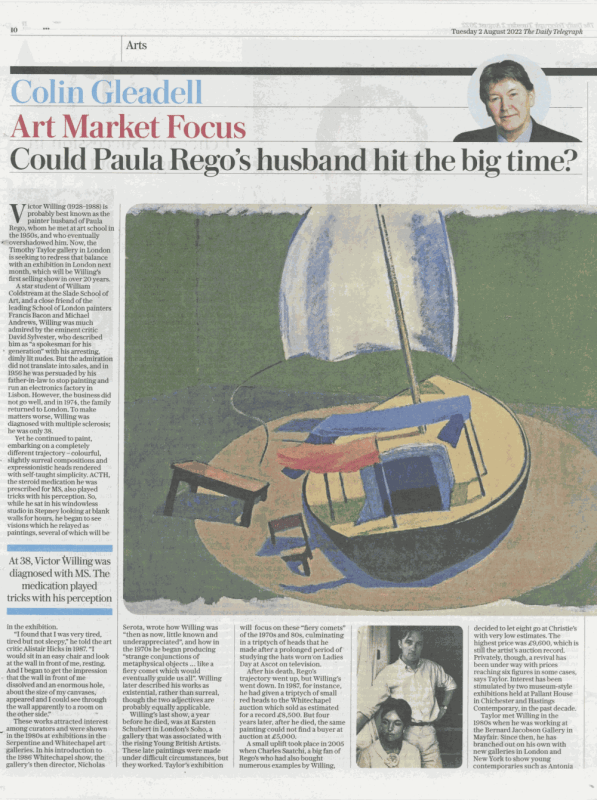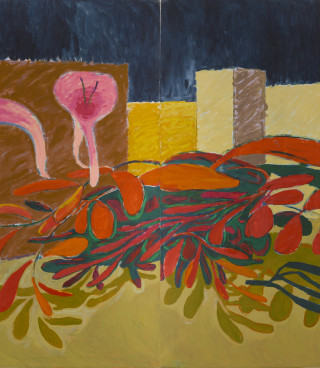Victor Willing (1928–1988) is probably best known as the painter husband of Paula Rego, whom he met at art school in the 1950s, and who eventually overshadowed him. Now, the Timothy Taylor gallery in London is seeking to redress that balance with an exhibition in London next month, which will be Willing’s first selling show in over 20 years.
A star student of William Coldstream at the Slade School of Art, and a close friend the leading School of London painters Francis Bacon and Michael Andrews, Willing was much admired by the eminent critic David Sylvester, who described him as “a spokesman for his generation” with his arresting, dimly lit nudes. But the admiration did not translate into sales, and in 1956 he was persuaded by his father-in-law to stop painting and run an electronics factory in Lisbon. However, the business did not go well, and in 1974, the family returned to London. To make matters worse, Willing was diagnosed with multiple sclerosis; he was only 38.
Yet he continued to paint, embarking on a completely different trajectory – colourful, slightly surreal compositions and expressionistic heads rendered with self-taught simplicity. ACTH, the steroid medication he was prescribed for MS, also played tricks with his perception. So, while he sat in his windowless studio in Stepney looking at blank walls for hours, he began to see visions which he relayed as paintings, several of which will be in the exhibition.
“I found that I was very tired, tired but not sleepy,” he told the art critic Alistair Hicks in 1987. “I would sit in an easy chair and look at the wall in front of me, resting. And I began to get the impression that the wall in front of me dissolved and an enormous hole, about the size of my canvases, appeared and I could see through the wall apparently to a room on the other side.”
These works attracted interest among curators and were shown in the 1980s at exhibitions in the Serpentine and Whitechapel art galleries. In his introduction to the 1986 Whitechapel show, the gallery’s then director, Nicholas Serota, wrote how Willing was “then as now, little known and underappreciated”, and how in the 1970s he began producing “strange conjunctions of metaphysical objects… like a fiery comet which would eventually guide us all”. Willing later described his works as existential, rather than surreal, though the two adjectives are probably equally applicable.
Willing’s last show, a year before he died, was at Karsten Schubert in London’s Soho, a gallery that was associated with the rising Young British Artists. These late paintings were made under difficult circumstances, but they worked. Taylor’s exhibition will focus on these “fiery comets” of the 1970s and 80s, culminating in a triptych of heads that he made after a prolonged period of studying the hats worn on Ladies Day at Ascot on television.
After his death, Rego’s trajectory went up, but Willing’s went down. In 1987, for instance, he had given a triptych of small red heads to the Whitechapel auction which sold as estimated for a record £8,500. But four years later, after he died, the same painting could not find a buyer at auction at £5,000.
A small uplift took place in 2005 when Charles Saatchi, a big fan of Rego’s who had also bought numerous examples by Willing, decided to let eight go at Christie’s with very low estimates. The highest price was £9,600, which is still the artist’s auction record. Privately, though, a revival has been under way with prices reaching six figures in some cases, says Taylor. Interest has been stimulated by two museum-style exhibitions held at Pallant House in Chichester and Hastings Contemporary, in the past decade.
Taylor met Willing in the 1980s when he was working at the Bernard Jacobson Gallery in Mayfair. Since then, he has branched out on his own with new galleries in London and New York to show young contemporaries such as Antonia Showering and Honor Titus, and such post-war European masters as Antoni Tapies and Simon Hantai, who are hitting the million-pounds mark now. Taylor doesn’t want to group Willing with the oldies, but with the younger generation because his “defined image” fits better, he says. Certainly, Surrealist-inspired young artists are all the rage.
Young collectors may not know anything about Willing yet, but Taylor has confidently priced his work from £8,000 for drawings to £150,000 for the largest painting in his exhibition – the visionary, 13ft-wide, burgeoning golden apple tree, Cythère.
Victor Willing: Could Paula Rego's husband hit the big time?
Colin Gleadell, The Telegraph, 2 August 2022

